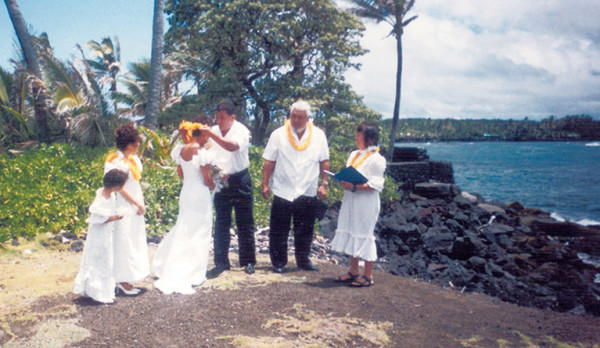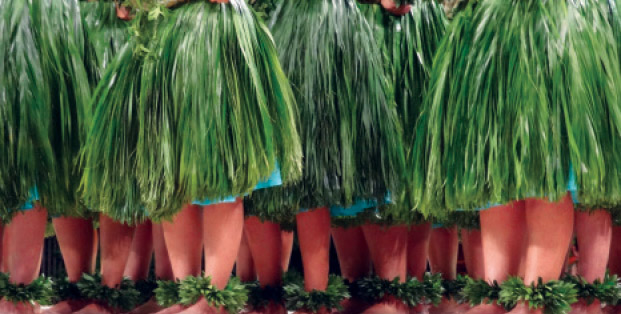
Adorning the Dancers: Understanding the Plants of Hula
 By Denise Laitinen
By Denise Laitinen
Standing next to the kahua hula (dance platform) that overlooks Halema‘uma‘u Crater at the Hawai‘i Volcanoes National Park, you can see a plume of steam and gasses rising from the crater, home of the volcano goddess Pele. On this clear bright day, surrounded by a forest of ‘ōhi‘a lehua trees with their rich red blossoms, you can feel the mana of the land.
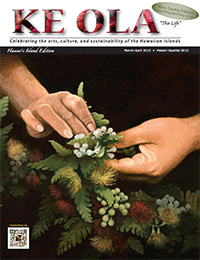
Ab Kawainohoikala‘i Valencia, kumu hula for Hālau Hula Kalehuaki‘eki‘eika‘iu, is explaining the various plants and flowers used by hula dancers when they perform. “The kino lau (the manifestation of Hawaiian deities in plant forms) will determine what flowers are used in a particular hula,” explains Valencia.
“The hula determines which plant we’ll use. The plant does not determine the hula.” There are two types of plants used in hula: plants used for the hula kuahu (altar), and hula adornment plants or lei.
Kuahu hula plants include maile, ‘ie‘ie, ‘ilima, lehua, and halapepe. Some plants, such as ‘ie‘ie, and maile are considered sacred to the hula goddess Laka, while others, such as the lehua, are considered sacred to Pele.
Adornments — plants worn by the hula dancers — include maile, ‘ilima, lehua, palapalai, and ‘a‘ali‘i, among others.
Sometimes hula altar plants may be used in lei worn by dancers and sometimes not. Hula dancers wear different types of lei: lei po‘o (head lei), lei ‘ā‘ī (neck lei), kūpe‘e (lei for wrist and ankles).
“Depending on the hula that we are doing, if it is for Pele, we will use liko (the young shoots of the ‘ōhi‘a); we’ll use lehua (the flower) [as lei].”
“If it’s for Hi‘iaka, we’ll use palapalai, which is a fern. Palapalai is kino lau for Laka as well,” explains Valencia.
“Red lehua is always used in reference to Pele.”

However, red and yellow lehua (mamo) are significant to ali‘i and mamo also indicates offspring.
“For instance if the hālau were to perform a hula of an ali‘i as a young person, they might wear mamo flowers to reference the ali‘i as a youngster.
“It all depends on the hula we are performing,” explains Valencia. In years past his hālau have traveled to Kaua‘i to perform at the Queen Emma hula festival held in Kōke‘e every October. While the event is on Kaua‘i, the dance is about Queen Emma, who is from O‘ahu.
“If we are performing a hula about Queen Emma I may dress my dancers in liko lehua as a lei po‘o (head lei), but if I’m doing an Emma number and knowing that she is from O‘ahu, then I will dress my dancers in ‘ilima [the official flower of O‘ahu].
“The ‘ilima represents her O‘ahu connection and the liko represents our Hawai‘i Island connection.”
Not every plant represents a god or goddess.
“We use the a‘ali‘i, but it doesn’t belong to anybody [particular Hawaiian god or goddess],” says Valencia. “The ti leaf doesn’t belong to anybody.”
He notes that ti plants, called kī in Hawaiian, are a canoe plant brought here by Polynesians. Considered a sacred symbol of the gods and an emblem of divine power, the plants are seen as a symbol of protection against evil.
And while ti plants are commonly used in hula, such as for skirts in hula kahiko, as well as in hula ‘auana dances (modern hula), not every Hawaiian plant is usable in hula because not every plant can stand up to usage.
“You wouldn’t use kupukupu (a fern) because it would start to droop,” says Valencia, explaining that the laua’e fern is more commonly used.
“However, palapalai is the best. The substitute for palapalai is pala‘ā, which is very fragile.”
Valencia noted that some hālau are starting to grow their own palapalai because it can be hard to find. Maile, another important hula plant, is also hard to find in the wild. “Some hālau have started to grow their own plants. They’ll grow their own gardens at their home or someplace they can tend to them because some plants are getting harder and harder to find.
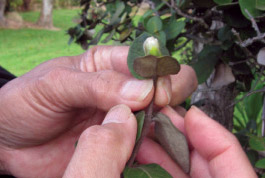
“Maile is very very difficult to get in the wild these days,” says Valencia. “If we know we’re going to need maile, then I will try to order it from a flower shop.”
Valencia says that while he uses palapalai and maile, “Liko and lehua are my favorite.” It’s little wonder these are his favorite flowers since the English translation of his hālau’s name, Hālau Hula Kalehuaki‘eki‘eika‘iu, is “the majestic lehua blossom in the heights.”
“Up here, the materials are available to us. I understand that elsewhere it’s very difficult, especially if you come from another island. [Hālau] have to go further and further to find materials.
“I tell my dancers they have to know where their plants are going to come from. They need to have five or more places where they have their spots. And then once they find them, not to tell anyone,” he says with a laugh.
“As a kumu hula you have to have all these sources. You have to know where to get it if you can and if not, you have to be prepared to make substitutions.
Hālau from Kona or Kohala have their sources and their resources that they use. “The challenging ones are the hālau from O‘ahu because it is a difficult spot. It’s the most populous and it has the most hālau.
“Because it is getting more and more difficult to get the native plants to dress dancers, we have to be very careful and very respectful of the resources.”
Hālau follow certain protocol when gathering plant material for adornment of the hula dancer. First and foremost is to always ask permission.
“As a kumu hula I will chant a protection chant, to allow us to go into the forest, as well as a chant asking permission to pick plants in the forest.”

“Depending on the situation and what we are gathering for, either I will perform the chant as kumu hula or the entire hālau will perform the oli (chant).”
Valencia notes that gathering plant material isn’t a social party time.
“If we are in the forest, it is the realm of the gods and the other beings. It’s their home. We need to be respectful,” says Valencia.
“We are the guests. For us too, sometimes too much noise attracts other spirits and we don’t want them to be nīele (nosy) and come look and see what’s going on while we’re there. We try to pick quietly and respectfully and leave.”
Another key element of gathering plant material is to only pick what is needed.
“We pick only what we know what we are going to use. We also clean [the tree branches] while we are in the forest.”
Valencia says that while his hālau can apply for a picking permit to gather flowers within the Hawai‘i Volcanoes National Park, he points out that the park has stringent rules and regulations about gathering.
“The park allows us to pick but they have very strict protocol about who can come and who cannot. If I know I need some things, then I will come in as the leader of the group. I need to get the permit. They only allow four people to come in and pick at any one given time.”
However, since he and multiple members of the hālau live in the Volcano area where ‘ōhi‘a trees are plentiful, his hālau are able to gather outside of the park.
It should be noted that his hālau, and hula dancers in general, do not gather plant material needlessly. “The important thing for us as hālau is that we have to have a reason to pick [plants and flowers]. We don’t go and pick just because.”
“For me, it’s strictly for a hula performance for things we need to do. Once I decide [what flowers will be used], then there are protocol from beginning to end.”
“You can go and admire the different hula plants but unless you have a reason to pick I really don’t recommend that people do so. And they should always follow the direction of their kumu.”
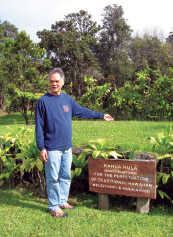
The types of flowers and plants to be used in a performance determine when the plants are picked. “If we’re using liko, then we would pick a week in advance. If we’re using ferns, then we would pick two days in advance.”
Valencia explains there is a time sequence that needs to be followed in preparation for a performance.
“You want the dancers on the day of the performance to be totally prepared for the dance, not spending hours and hours the night before making their lei and getting their costumes ready. They make the lei up to a week in advance, which means that all the other things that they need—their costumes, the instruments—all need to be prepped. We try to space it out so that there is time for them to carefully put things together.”
When the performance is finished, the plant materials are returned back to nature.
“After the performance we always return our lei to the land or to the forest,” says Valencia. “I tell my students to return it to the land or their garden.” ❖
 There are a variety of places around the island where hula plants can be viewed. Several plants used in hula can be found throughout Hawai‘i Volcanoes National Park. Visitors can take a short, guided tour at the Visitors Center, which includes a stop at the nearby hula platform.
There are a variety of places around the island where hula plants can be viewed. Several plants used in hula can be found throughout Hawai‘i Volcanoes National Park. Visitors can take a short, guided tour at the Visitors Center, which includes a stop at the nearby hula platform.
In west Hawai‘i, folks wanting to learn about various hula plants can take self-guided tours at the Amy Greenwell Ethnobotanical Garden in Captain Cook. The 15-acre garden features over 200 species of endemic, indigenous, and Polynesian introduced plants in gardens at elevations ranging from sea level to upland forest.
The gardens are organized by biogeographical zone, typical of a Kona ahupua‘a, or traditional Hawai‘i land division.
“Our gardens include ‘ōhi‘a, maile, ‘ie‘ie, as well lama, a‘ali‘i and pa‘u o hi‘iaka,” says Peter Van Dyke, manager of the Garden.
Van Dyke says that this time of year, it’s common for visiting hālau to come and pick ti leaves at the Garden.
“A few weeks before the Merrie Monarch Festival hālau come and pick ti leaf.”
“We have a lot of ti leaf,” says van Dyke. So [when hālau gather ti leaf] it doesn’t even make a dent in our garden.”
“We welcome hālau looking for ti leaf to come to our garden.”
Photo Credits: Hālau Hula Kalehuaki‘eki‘eika‘iu, Renée Robinson
Contact writer Denise Laitinen.

